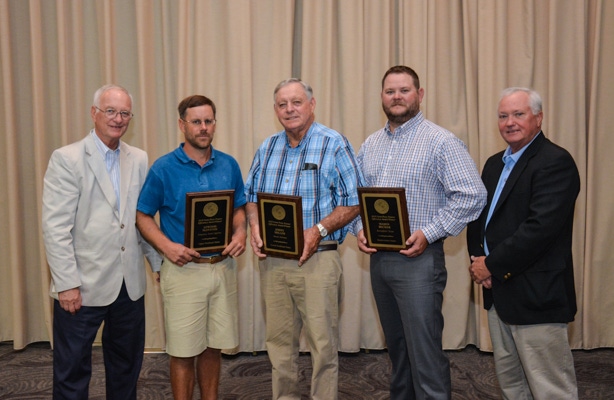
Three exceptional peanut farmers, from three distinctly different growing environments, fielded questions from a knowledgeable audience to close out the 19th annual Farm Press Peanut Efficiency Awards breakfast Saturday during the Southern Peanut Producers Conference at the Sandestin Golf and Beach Resort on Miramar Beach, Fla.
Farmers Mason Becker, Terry County, Texas; Atwood McIntosh, Kingstree, S.C.; and Jimmy Miller, Snead, Ala., deftly answered questions on fertility, seeding rates, pest management, marketing, and organic peanut opportunities.
Production systems among the three ranged from non-irrigated, mostly irrigated and 100 percent irrigated but with limited water resources. Disease management accounted for one of the most variable production practices.
They responded to a disease management question from University of Georgia Professor Bob Kemerait.
McIntosh, who farms in the humid South Carolina Low Country, typically applies fungicides six or seven times a season. “On my irrigated peanuts, production risk is less, so I can justify the fungicide expense,” he said.
Miller gets by with no more than five preventive fungicide applications a year, “sometimes six to control leafspot. I occasionally spray for white mold, too.”
He does not skimp on fungicides. “We have so much invested by the time we get planted, I won’t let spending $90 to $100 an acre on fungicide get in the way of making a crop.”
“We are in a dry region,” Becker said. “Annual rainfall ranges from 16 to 18 inches or less, and we are currently in a drought. It’s not unheard of to spray no more than one or two times a season. Sometimes we see a little leafspot.”
They fielded a question on what they need to push profitability.
“Improved water use efficiency,” Becker said. “With limited rainfall, we have to be efficient with irrigation. We can’t make a crop with only irrigation; we need some rain.”
“We look for newer varieties to get us to the next level, McIntosh said. “We push further and further.”
“We can’t expect yields to go much higher on dryland acreage,” said Miller. He’s averaging better than 4,000 pounds per acre. “We need to get rid of surplus peanuts to move the market,” he added.
Organic Peanut Potential
Asked about the potential to increase organic peanut acreage, Becker said he planted half (240 acres) of his 2018 peanut acreage in organic peanuts.
“We’ve seen a large influx of organic peanuts in the area,” he added. “We’ve seen a lot grassland come out of CRP, and that is ideal for organic production. We don’t get a lot of broadleaf weeds in the CRP acreage. It’s much harder and takes longer to transition conventional acreage to organic.”
He said a producer still must find good soil for peanuts, including adequate water. And be prepared for weed control. “I spend about $100 per acre on hoeing,” he said.
He added that his organic peanuts bring in about three times more than conventional, $1200 a ton. “If folks are willing to pay more for organic, I’m willing to plant them.”
McIntosh says with the humidity and disease pressure in the Coastal Plain of South Carolina, organic would not be feasible.
“That is an advantage in the Southwest,” Becker added. “If had a lot of disease pressure, we couldn’t grow organic. We can’t apply fungicides.”
He plans to include organic cotton and organic sorghum in rotation to maintain organic acreage.
New Technology
Another audience member asked: What new technology would you like to see?
“Variety improvements,” said Miller. “I would like to have an earlier-maturing runner peanut. Producing in the northern edge of the peanut region, we have to plant early.”
He said cutting 20 to 25 days off the maturity at the end of the season would allow him to harvest ahead of cold weather.
McIntosh, who already uses soil moisture probes to schedule irrigation, said some “underground technology to monitor moisture,” would be useful.
“Autonomous equipment,” Becker said, would help farmers manage large acreage more efficiently. “I’m excited to see what they develop.”
Marketing
Marshall Lamb, research leader, USDA National Peanut Research Laboratory, asked about marketing opportunities.
McIntosh works with one company consistently to maintain a relationship and looks for decent contract offerings.
Miller looks for contact opportunities, too, but did not book anything this year because prices were too low. “If I can’t see a profit, I don’t book the crop,” he said.
Becker contracts before he plants. “I need to know what I’ll get before I make the investment,” he said.
Lamb said export demand may move the market and provide better pricing options.
Innovations
Responding to other questions, producers acknowledged that equipment innovations such as autosteer and variable rate technology has improved efficiency.
“I used to think I did not need a guidance system to drive a tractor,” Miller said, “but when I’m knee deep in peanut vines and can’t see the rows, it makes a difference.”
Kemerait also asked the growers to explain how they choose varieties. Yield tops the list, but they also look for disease resistance and market opportunities.
“Profitability is the key,” Becker said. “I look at what’s conducive to the area, but I usually plant two or three varieties to diversify.”
Miller said buyers want hi-oleic peanuts.
In accepting the awards, each PEA winner expressed gratitude for being able to farm, thanked their families for their support and humbly acknowledged that many of their neighboring farmers were equally deserving.
One observers from the audience, however, expressed to Farm Press staff that this may be the best of the 19 award classes.
About the Author(s)
You May Also Like






